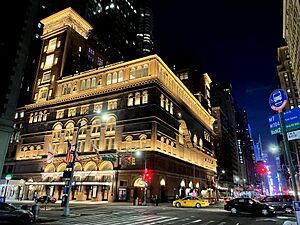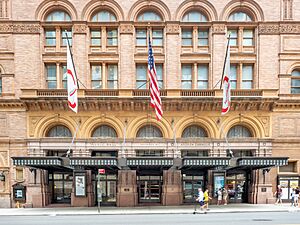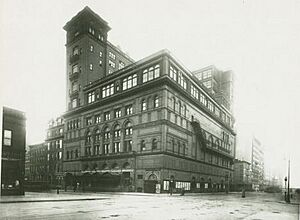Carnegie Hall facts for kids
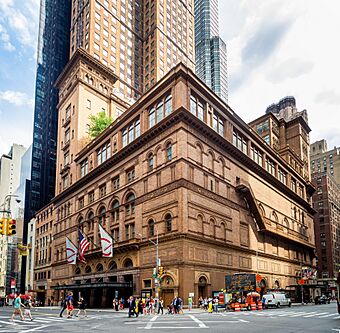
Carnegie Hall in 2019
|
|
| Address | 881 Seventh Avenue (at 57th Street) Manhattan, New York United States |
|---|---|
| Public transit | Subway: 57th Street–Seventh Avenue |
| Owner | Government of New York City |
| Operator | Carnegie Hall Corporation |
| Type | Concert hall |
| Capacity | Stern Auditorium: 2,804 Zankel Hall: 599 Weill Recital Hall: 268 |
| Construction | |
| Opened | April 1891 |
| Architect | William Tuthill |
| Builder | Andrew Carnegie |
| Website | |
| carnegiehall.org | |
|
Carnegie Hall
|
|
| Architectural style | Renaissance Revival |
| NRHP reference No. | 66000535 |
| Significant dates | |
| Added to NRHP | October 15, 1966 |
| Designated NHL | December 29, 1962 |
Carnegie Hall is a very famous concert hall in Midtown Manhattan, New York City. It is located at 881 Seventh Avenue, between 56th and 57th Streets. This amazing building was designed by architect William Burnet Tuthill. It was built by a rich businessman and helper of others, Andrew Carnegie, who the hall is named after.
Carnegie Hall is known as one of the best places in the world for both classical and popular music. It has its own teams that plan shows and market them. About 250 performances happen there every year. Other music groups also rent the hall for their shows.
Carnegie Hall has 3,671 seats in total, spread across three main rooms. The biggest room is the Stern Auditorium, which has 2,804 seats on five levels. There is also the 599-seat Zankel Hall and the 268-seat Joan and Sanford I. Weill Recital Hall. The building also has offices on its top floors.
Carnegie Hall was first called the Music Hall. It was built between 1889 and 1891 for two music groups. The Carnegie family owned the hall until 1925. Later, it was almost torn down in the 1950s. This was because the New York Philharmonic orchestra was moving to Lincoln Center. But a famous violinist named Isaac Stern led a public effort to save it. Carnegie Hall is now a National Historic Landmark. This means it is a very important historical place. It has been fixed up many times over the years, including in the 1940s and 1980s.
Contents
Location of Carnegie Hall
Carnegie Hall is on the east side of Seventh Avenue. It is between 56th Street and 57th Street in Midtown Manhattan, New York City. This spot is just two blocks south of Central Park. The building takes up a large area, about 27,618 square feet. It covers the whole block from 56th Street to 57th Street. It also stretches about 150 feet east from Seventh Avenue.
Carnegie Hall shares its block with other buildings like the Carnegie Hall Tower. Nearby, you can also find the Russian Tea Room and the Metropolitan Tower. Right outside the hall, there is an entrance to the New York City Subway's 57th Street–Seventh Avenue station.
The area around West 57th Street used to be a big center for artists. Many buildings were built there for artists and musicians to live in. These included places like the Osborne and the Rodin Studios. Over time, this artistic area changed. By the 2000s, it became known as Billionaires' Row. This area now has many tall, fancy skyscrapers.
Building Design and Performance Spaces
Carnegie Hall was designed by William Tuthill. He was an amateur musician, which might have helped him get the job. Dankmar Adler, a very experienced designer of music halls, helped with the sound design. The building was made with strong, heavy brick walls. This was because lighter steel frames were not common back then. The building's style is like a changed Italian Renaissance design.
Carnegie Hall is made of three parts that form an "L" shape. Each part holds one of the hall's performance rooms. The main building, which has the Isaac Stern Auditorium, is eight stories tall. It is at the corner of Seventh Avenue and 57th Street. The eastern part is 16 stories tall and holds the Weill Recital Hall. The southern part is 13 stories tall and has Zankel Hall.
Outside Look
Carnegie Hall has an outside made of reddish-brown brick. It is decorated with many details from the Renaissance period. Other decorative parts, like bands and arches, are made of a special clay material called terracotta. When it was first built, the roof was black.
The original part of the building has three main sections. The bottom section has the first floor and a small floor above it. The main entrance has five large arches. Above these arches, you can see the words "Music Hall Founded by Andrew Carnegie." The middle three arches lead to the Stern Auditorium's lobby. The other two arches lead to stairs for the upper floors. There are similar doorways on Seventh Avenue.
Above the main entrance, on the third and fourth floors, there is another section with five arches. A balcony with a railing is in front of these arches. The sixth floor has five square openings, each with two arched windows. The seventh floor used to be a sloped roof. But it was changed to a straight wall that looks like a row of arches. The flat roof was turned into a garden. The building was also made bigger at the corner of Seventh Avenue and 56th Street. This new part has a large dome and smaller domes at its corners.
Performance Rooms
Stern Auditorium/Perelman Stage
The Stern Auditorium is the biggest performance space. It is six stories high and has 2,804 seats on five levels. It was renamed in 1997 after violinist Isaac Stern. This was to honor him for saving the hall from being torn down in the 1960s. This main hall used to be home to the New York Philharmonic orchestra from 1892 to 1962.
You enter the Stern Auditorium through the Box Office Lobby on 57th Street. The lobby is three stories high. Its ceiling is curved and decorated with white and gold designs. The walls were painted a salmon color. The lobby was originally a few feet above the street. But in the 1980s, it was lowered to street level. The new lobby has geometric designs and fancy columns with lights.
You can reach most levels by elevator. The top balcony is 137 steps above the main floor. The lowest level is called the parquet level. It has 1,021 seats. The first and second levels have 65 private boxes. The Dress Circle is above the parquet level and has 444 seats. The highest level is the balcony, with 837 seats. Some seats have blocked views, but only the Dress Circle has columns that might get in the way.
The stage, called the Ronald O. Perelman Stage, is 42 feet deep. It used to have six parts that could move up and down. During a renovation in the 1980s, new areas were added behind the stage. These included a stage wing, an orchestra room, and dressing rooms.
Zankel Hall
Zankel Hall is on the Seventh Avenue side of the building. It is named after Judy and Arthur Zankel, who helped pay for its renovation. This was the first room to open to the public in April 1891. It was originally called Recital Hall. It had a balcony, raised side areas, and seats that could be moved. It could hold over 1,000 people and was used for concerts and banquets.
After some changes in 1896, it was renamed Carnegie Lyceum. It was later turned into a movie theater in 1961. But in 1997, it became a performance space again.
Zankel Hall was completely rebuilt and opened in September 2003. You enter it from Seventh Avenue. Two escalators take you to the seating levels. The stage can be set up in different ways. This is because the floor is divided into nine sections that can move up and down. Zankel Hall has 599 seats on two levels. The lower level has 463 seats, and the upper level has 136 seats. There are also private boxes on both levels.
Building Zankel Hall was very difficult. Workers had to dig deep under the building, very close to the subway tunnel. They also had to remove large columns that supported the main hall. Special soundproofing was added to block noise from the street and subway. The walls are sloped and covered with sycamore wood.
Weill Recital Hall
The Joan and Sanford I. Weill Recital Hall is named after Sanford I. Weill and his wife Joan. This room has been used since the hall opened in 1891. It was first called Chamber Music Hall. It was renamed Carnegie Recital Hall in the late 1940s. It got its current name in 1986 and reopened in January 1987.
The recital hall has its own lobby, which is light-colored with red metal designs. Before a renovation in the 1980s, it shared a lobby with the main auditorium. The Weill Recital Hall is the smallest of the three performance spaces. It has 268 seats in total. The lower level has 196 seats, and the balcony level has 72 seats. The room now has off-white walls and blue seats. In the 1980s, some parts that were added later were removed to make the sound better. The room has three chandeliers that also help with the sound.
Other Areas
Carnegie Hall also had other facilities. There was a boiler room and a small power plant for lights. The main hall's ground floor had a lobby with gray marble and salmon-colored walls. Stores and a restaurant were added to the lobby in the 1940s. But these were removed during a renovation in the 1980s.
The eighth floor of the main hall had studios. There were about 133 or 150 studios. Many artists lived and worked in these spaces. Famous people like Leonard Bernstein and Martha Graham lived there. These studios had high ceilings and large windows for natural light. Andrew Carnegie wanted these spaces to earn money to help support the hall. After 1999, the studios were changed into music education rooms and offices. The last artist living there moved out in 2010.
The building also has the Carnegie Hall Archives, which started in 1986. It also has the Rose Museum, which opened in 1991. The museum has dark and light wood panels and brass details.
History of Carnegie Hall
The idea for Carnegie Hall came from Leopold Damrosch. He was the leader of two music groups in New York. His son, Walter Johannes Damrosch, continued his father's dream after Leopold passed away. In 1887, Walter met Andrew Carnegie, who agreed to give $2 million to build a new music hall. At that time, most concert halls in New York City were further downtown. The area around 57th Street was mostly homes.
Building and Opening
In March 1889, land was bought for the new music hall. William Tuthill was hired to design a "great music hall." It was planned to be a five-story brick and limestone building. It would have a main hall with 3,000 seats and smaller rooms for practice and concerts. The Music Hall Company was started on March 27, 1889. Andrew Carnegie owned most of the company. The total cost of the building was expected to be $1.1 million.
Andrew Carnegie's wife, Louise, laid the first stone for the Music Hall on May 13, 1890. Andrew Carnegie said the hall would be a "shrine of the goddess of music." The Recital Hall opened in March 1891. The main Music Hall officially opened on May 5, 1891. A famous Russian composer, Pyotr Ilyich Tchaikovsky, helped conduct the first concert. Tchaikovsky thought the hall was "unusually impressive and grand." The New York Herald newspaper praised the hall's sound, saying "each note was heard." The Music Hall cost $1.25 million to build. It was the second major concert hall in New York City.
From the Late 1800s to Mid-1900s
Early Years (1890s-1910s)
Right from the start, people were reselling tickets for more money. Ushers even sold empty seats at the start of shows. In 1892, the owners thought about making the hall bigger. They wanted to add a tall tower at the corner of Seventh Avenue and 56th Street. The main building's roof was also changed. The New York Philharmonic orchestra moved into the Music Hall in November 1892. The studios on top of the building were built between 1894 and 1896.
The American Academy of Dramatic Arts moved into the basement recital hall in 1896. Around this time, the Music Hall was renamed Carnegie Hall. This was to honor Andrew Carnegie and to avoid confusion with other "music halls" that were more like variety shows. In the early 1900s, many famous musicians performed at Carnegie Hall because of its great sound.
1920s to 1940s
Carnegie Hall was updated in 1920. Some stairs were removed, and offices were changed. By 1924, the Carnegie Foundation thought about selling the hall because it was losing money. In February 1925, Andrew Carnegie's wife sold the hall to a real estate developer named Robert E. Simon. The sale included a rule that Carnegie Hall had to stay a performance venue for at least five more years.
Under Simon's ownership, a new organ was put in Carnegie Hall in 1929. Robert Simon passed away in 1935. His son, Robert E. Simon Jr., became the vice president.
The main hall was changed around 1946 for a movie called Carnegie Hall. A hole was made in the stage ceiling for lights and air. This changed the sound in the front rows. In 1947, Robert E. Simon Jr. fixed up the hall again.
Saving the Hall
By the 1950s, Robert Simon wanted to sell the hall. The New York Philharmonic orchestra, which used the hall most often, planned to move to Lincoln Center. Simon told the Philharmonic that he would end their lease if they did not buy Carnegie Hall. In 1955, an employee named John Totten started a plan to raise money to save the hall.
In 1956, Simon sold the hall to a company called Glickman Corporation. They planned to tear it down and build a 44-story skyscraper. But Glickman could not get enough money for the skyscraper. Also, Lincoln Center was delayed. So, Glickman decided not to buy the building.
Meanwhile, Simon started thinking about how to save the hall. Violinist Isaac Stern asked his friends for help. In 1959, they thought the city government should get involved. The mayor, Robert F. Wagner Jr., supported saving Carnegie Hall. In 1960, a special law was passed. This allowed the city government to buy the hall from Simon for $5 million.
The city then rented the hall to the Carnegie Hall Corporation. This is a non-profit group that runs the venue. Carnegie Hall was named a National Historic Landmark in 1962. This means it is a very important historical place. The city also made it a city landmark in 1967.
Fixing Up the Hall
1960s and 1970s
Carnegie Hall had some small fixes in 1960. The basement recital hall became a movie theater called the Carnegie Playhouse. It opened in May 1961. In 1965, Carnegie Hall got a new organ. By the late 1960s, Carnegie Hall was doing well. It hosted about 350 shows each year.
However, the building started to get old and needed more repairs. By the mid-1970s, pipes were bursting, and parts of the ceiling were falling. The air conditioning system did not work in the summer. The costs to run the hall also went up a lot.
In 1977, the Carnegie Hall Corporation decided not to allow new people to live in the studios on the upper floors. They wanted to rent these spaces to businesses that could pay more. This caused protests from the artists who lived there. In 1979, the corporation hired a company to plan a big renovation. They found that the electrical systems and fire alarms were not up to modern safety rules. In 1981, the government gave Carnegie Hall $1.8 million for the renovation.
1980s
The first renovations started in 1982. The recital hall and studio entrance were fixed. The lobby was lowered to street level. A new lobby and elevator were made for the recital hall. The Carnegie Hall Corporation also wanted to build on an empty lot next to the hall. The renovation was hard because some of the original building plans were missing. There was also a problem when the corporation started asking artists to leave their studios. The first part of the renovation finished in 1983 and cost $20 million.
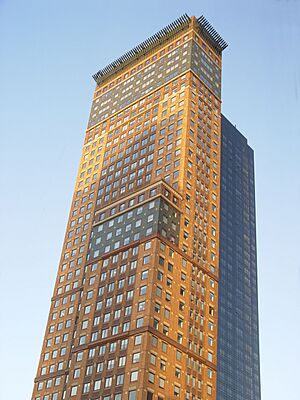
As part of the third phase of renovations, a recording studio was built on the fifth floor. It opened in March 1985. The corporation announced that the main hall and recital hall would close for several months. They also started raising $50 million for the renovation. A new building, later called the Carnegie Hall Tower, was planned for the empty lot next to Carnegie Hall.
The city approved the renovation in July 1985. Work began after that. The project was difficult because they had to work around performances. In April 1986, Carnegie Hall decided to rent the empty lot for the Carnegie Hall Tower. The hall closed completely for seven months in May 1986. The plaster decorations were fixed, and new carpets and seats were put in. In November, the recital hall was renamed after Joan and Sanford I. Weill. They had given a lot of money for the renovation.
The main hall reopened on December 15, 1986, with a big concert. The Weill Recital Hall opened in January 1987. A month later, a music critic said the sound in the main hall was not the same. The Weill Recital Hall also had sound problems. Noise-absorbing panels were added in 1988. Critics thought there was concrete under the stage, which could affect the sound. Carnegie Hall officials said there was no concrete. But in 1995, they found a slab of concrete when they took the stage apart. After the concrete was removed, critics said the sound improved.
1990s and Early 2000s
In the late 1980s, Carnegie Hall started collecting items for a museum. The Rose Museum opened in April 1991. It has its own entrance. Other new rooms were also created that year.
In the basement, the Carnegie Hall Cinema operated until 1997. Then, the hall's management closed the cinema and two shops. In 1998, Carnegie Hall announced it would turn the basement recital hall into another performance space. This project would cost $50 million. It was a high cost because they had to dig under the basement while concerts were still happening. The new space was named Zankel Hall in 1999. Construction happened without stopping performances or affecting the subway tunnel nearby. Zankel Hall opened in September 2003. A music critic praised its flexibility.
Recent Years
In June 2003, there were plans for the Philharmonic to return to Carnegie Hall. But these plans were dropped later that year. Zankel Hall opened in September 2003.
In 2007, Carnegie Hall Corporation announced it would ask all remaining artists to move out of the upper-story studios. The corporation wanted to turn the space into offices. By 2010, the last artist had moved out. In 2014, Carnegie Hall opened its Judith and Burton Resnick Education Wing. This new wing has 24 music rooms. One room is big enough for an orchestra or a choir. This project cost $230 million. It was paid for by donations and money from the city and state.
Carnegie Hall closed for a while in March 2020 because of the COVID-19 pandemic in New York City. The hall reopened on October 6, 2021, with a performance by the Philadelphia Orchestra. Carnegie Hall returned to a full schedule of shows during the 2022–2023 season. A new cafe, the Weill Cafe, opened in January 2024.
Events and Performances
Orchestra Performances
The first world premiere at Carnegie Hall was Symphony No. 9 by Antonín Dvořák. It was performed on December 16, 1893. In the 1900s, famous conductors and composers performed their own music there. These included Richard Strauss and Sergei Rachmaninoff. In its early years, Carnegie Hall hosted the New York Philharmonic and Symphony. Other orchestras like the Boston Symphony Orchestra also performed there often.
Famous solo musicians also gave concerts. Pianists like Arthur Rubinstein and Mieczysław Horszowski debuted there in 1906. They continued to perform there for many decades.
The NBC Symphony Orchestra, led by Arturo Toscanini, often recorded in the Main Hall. On November 14, 1943, the 25-year-old Leonard Bernstein had his first big conducting job there. He had to fill in for a sick conductor.
Other Concerts and Recitals
Carnegie Hall was open to all people from the start. This was different from some other places that were segregated. Sissieretta Jones was the first African-American person to sing at Carnegie Hall. This happened on June 15, 1892, less than a year after it opened.
Popular music was played at the hall as early as 1912. James Reese Europe's Clef Club Orchestra performed an early jazz concert. Many jazz artists have performed at Carnegie Hall. These include Benny Goodman, Duke Ellington, Louis Armstrong, Ella Fitzgerald, and Miles Davis. The Benny Goodman Orchestra had a sold-out jazz concert on January 16, 1938. Famous guest performers like Count Basie were there.
Rock and roll music first came to Carnegie Hall in 1955. Bill Haley & His Comets performed in a benefit concert. But rock acts were not regularly booked until February 12, 1964. That's when The Beatles performed two shows during their first trip to the United States. The promoter convinced Carnegie officials that it would help "international understanding." Led Zeppelin performed two concerts there in October 1969. Since then, many rock, blues, jazz, and country performers have played at the hall. Some bands had rules about how loud they could play. Jethro Tull performed a benefit concert in November 1970. Ike & Tina Turner performed a concert in April 1971. The band Chicago recorded a live album there in 1971.
In 2024, Puerto Rican singer Ivy Queen became the first reggaeton artist to headline a concert at Carnegie Hall.
Other Events
To celebrate its 125th anniversary, Carnegie Hall asked for 125 new music pieces to be created.
The hall has also been used for talks. Booker T. Washington gave a lecture there in 1906. Mark Twain gave his last public lecture there in the same year. The hall was also used for graduation ceremonies for colleges like the City College of New York.
Management and How it Works
As of 2021, the main leader of Carnegie Hall is Sir Clive Gillinson. He started in this job in 2005. Robert F. Smith has been the chairman of Carnegie Hall's board since 2016. In the year ending June 30, 2021, the Carnegie Hall Corporation had about $718 million in assets. Its total income was about $74 million, and its expenses were about $62 million.
Carnegie Hall Archives
In 1986, it was found that Carnegie Hall had not kept good records of its history. Many historical documents were spread out. To get ready for Carnegie Hall's 100th birthday in 1991, the management started the Carnegie Hall Archives. In 2021, the historical collections were renamed the Carnegie Hall Susan W. Rose Archives. This was to honor a longtime supporter.
Fun Stories About Carnegie Hall
The Famous Joke
There's a famous joke about Carnegie Hall: A person on Fifty-seventh Street in Manhattan stopped a famous violinist, Jascha Heifetz. They asked, "Could you tell me how to get to Carnegie Hall?" Heifetz replied, "Yes! Practice!"
This joke is a big part of the hall's history, but no one knows exactly where it came from. It was first seen in print around 1955. Some people say other musicians like Arthur Rubinstein or Dizzy Gillespie were in the joke. One story says the joke came from the wife of violinist Mischa Elman. She said her husband made the joke when tourists asked him for directions as he left the hall after a bad practice. The joke is often just told as a riddle. It shows how well-known Carnegie Hall is in American culture.
Other Stories
Other stories are told about Carnegie Hall. One is about a very hot day on October 27, 1917. Heifetz was playing his first concert in America at Carnegie Hall. After he played for a while, another violinist, Mischa Elman, wiped his head and asked if it was hot. Pianist Leopold Godowsky, sitting nearby, replied, "Not for pianists."
While the Elman/Godowsky story is true, other stories might not be. One story is about violinist Fritz Kreisler and pianist Sergei Rachmaninoff. They were supposedly playing a Beethoven sonata. Kreisler got lost in the music. After playing on his own for a few minutes, he supposedly asked, "For God's sake, Sergei, where am I?" Rachmaninoff was said to have answered, "In Carnegie Hall."
See also
 In Spanish: Carnegie Hall para niños
In Spanish: Carnegie Hall para niños


